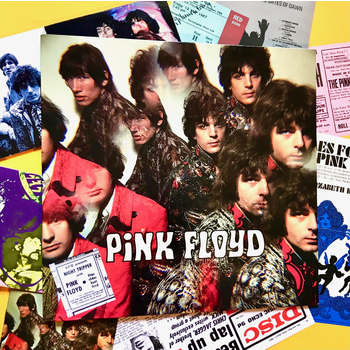FOLLOW THE PIPER
Author: Bruce Jenkins Date Posted:1 April 2022

While Pink Floyd were in Abbey Road’s Studio Three creating their debut album The Piper At The Gates Of Dawn, The Beatles were in the adjoining studio recording Sgt Pepper’s Lonely Hearts Club Band. It was February 1967, and things were totally groovy, baby.
Having released a couple of singles and built a solid live following in swinging London, Pink Floyd were excited to be doing sessions for an LP. Committing the odd, beguiling songs of Syd Barrett to tape wasn’t easy, yet the young band enjoyed exploring the possibilities of the recording studio, creating arrangements to compliment the eccentric psychedelia of Barrett’s ditties. Keyboard player Rick Wright observed,
The first thing that came into his head were the lyrics, and his next priority was making the words rhyme. He’d come up with a melody later, but never paid much attention to time signatures. Syd’s songs were great, but the tempos were always changing. That made things quite difficult for the band. [mojo4music.com]
While Wright, drummer Nick Mason and Roger Waters (bass) were all studying architecture, Syd Barrett was enrolled at art school. It was the wayward leader’s colourful vision that guided the band through those early times, yet somehow Barrett himself became lost. After his erratic behaviour and drug-related decline threatened the band’s very existence he was reluctantly left behind, replaced by fellow Cambridge musician David Gilmour. The paths of the crazy diamond and the ambitious rock band diverged forever.
But back in the first half of 1967, everything was bursting with possibilities. The Beatles had come to see Floyd at their UFO club gig, while the single “Arnold Layne” had generated radio airplay and controversy. Its lyric about a washing line thief with a penchant for cross-dressing was only one example of Syd’s unique take on pop. No songs about cars or love or being hip and groovy here. Instead, we have…
Space and underground lakes
A Siamese cat
Child entranced by a fantasy story
Unicorns, tripping
Gnomes, discovering drugs
A Scarecrow
The I Ching
Childlike infatuation
The music offers a unique combination of apparently disparate themes and divergent musical textures—experimental disorder in “Interstellar Overdrive”, fairytale credulity in “The Gnome”. When coupled to unpredictable song structures, the secret of Piper’s freshness is revealed as a kaleidoscope vision.
Moreover, the inclusion of the rambling ten minute improvisation “Interstellar Overdrive” was a nod to Pink Floyd’s live shows of the era, where the band, immersed in their multi-colour light show, would travel the endless space ways. Reflecting on the contrast between the record and the shows, guitarist David Gilmour observed, “I loved the first album but I thought the gigs were pretty interminable. It was too anarchic.” [Mojo Magazine].
Gilmour isn’t the only band member who thinks fondly of Piper. Interviewed decades later for a book on Pink Floyd, Rick Wright said, a trifle sadly, “I love listening to it, just to listen to Syd’s songs”.
Certainly Pink Floyd’s debut is the album upon which the legend and mythology of Syd Barrett is mostly based. Which is why the mono re-issue of Piper is so welcome. Mono, as any Beatles fan will tell you, was the benchmark for sound in 1967. If it didn’t sound good coming out of a small transistor speaker, it didn’t cut the mustard. And The Piper At The Gates Of Dawn does sound good in mono. Or stereo. Through speakers. Or headphones…
It is a remarkable debut that still weaves a spell.
© Bruce Jenkins 2022
SOURCES
Mark Blake (2007) Pigs Might Fly: The Inside Story of Pink Floyd. Aurum Press, London UK.
Nicholas Schaffner (1991) Saucerful of Secrets: The Pink Floyd Story. Sidgwick & Jackson, London UK.
MOJO: The Music Magazine (May, 1994; page 88)




